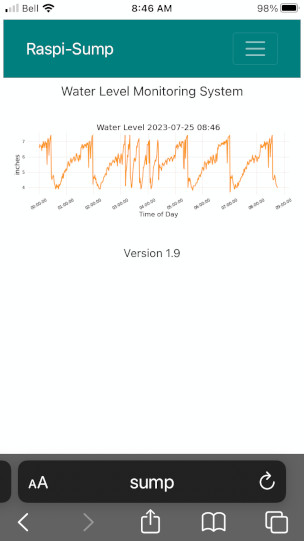Raspi-sump is a sump pit water level monitoring system that uses a Raspberry Pi and an Ultrasonic Sensor (HC-SR04).
Currently the system monitors the water level in your pit at defined intervals. It sends email sms alerts if the water reaches a critical level, indicating a possible sump pump failure.
Version 1.9 - Systemd is now an option to replace crontab. Control all Raspi-Sump services and Chart creation timers with Systemd.
You can continue using crontab if you prefer.
See the changelog for the latest information on Raspi-Sump features.
Raspi-Sump is currently supported on Raspberry Pi OS (Bullseye) and Raspian (Buster)
Plans are in the works for Raspberry Pi OS Bookworm. However changes to Python require a rethink on how Raspi-Sump is installed. More to come. For the time being, Bookworm is not supported.
Discuss and get support from other users. Email (alaudet@linuxnorth.org) for an invite link.
Full install instructions are located at https://github.com/alaudet/raspi-sump/blob/master/docs/install.md
Upgrade an existing version
sudo pip3 install -U --no-binary :all: raspisump
If upgrading from version 1.8 or lower to version 1.9 see the 1.9 Upgrade Instructions
Further details provided at https://www.linuxnorth.org/raspi-sump/
You are welcome to use Raspi-Sump but there is no guarantee it will work. Your house may still flood if your sump pump fails. This software comes with no warranty. See License details.
This is not a replacement for a properly maintained water pumping system. It is one tool you can use to give yourself extra piece-of-mind.
Best practices should include:
- A backup pump that triggers at a slightly higher water level than your main pump.
- The secondary pump should be connected to a seperate dedicated electrical breaker.
- You should also have a generator that can provide power should you have an extended outage during the spring or other unseasonally wet time of year.
- if you are building a new home, pay attention to the grade of your property, as you may be able to let gravity empty your pit for you. That would be the best approach with a backup pump for added protection.
Once you have done all of these things, then consider using a monitoring system like Raspi-Sump.
Raspi-Sump is released under the MIT License.
Please refer to the Contributing Guidelines before issuing a pull request.
